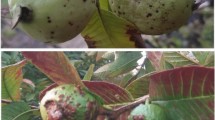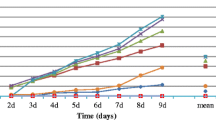Summary
The paper deals with some cultural and physiological studies of a strain ofPhytophthora palmivora Butler, causing fruit rot ofAchras sapota L. Among the various culture media studied, oat meal, corn meal, lima bean and rice meal agars were the best ones, with abundant growth and sporulation of the organism. Lactose, galactose, dextrin and glycogen were the best sources of carbon. Among the various nitrogenous compounds studied, ammonium phosphate (monobasic), ammonium sulphate, ammonium tartrate, ammonium lactate, asparagin, glycine and glutamic acid were the best ones utilized by the organism. A pH of 5.9 was found to be the optimum for the growth and sporulation.
Similar content being viewed by others
References
Leonian, L. H. (1925). Physiological studies on the genusPhytophthora. West Virginia agric. Expt. Sta. Sci. Paper11 444–498.
Lilly, V. G. &Barnett, H. L. (1951). Physiology of the Fungi, Mc. Graw-Hill Book Company. Inc. New York.
Mehrotra, B. S. (1952). Physiological Studies in somePhytophthoras-III. Carbon requirements. Rev. appl. Mycol.31 199.
Newton, W. &Lapatecki, L. E. (1954). The nutrition ofPhytophthora species. Rev. appl. Mycol.32 312.
Rao, V. G. (1960). Fruits rots of Chiku (Achras sapota L.) and Sitaphal (Anona squamosa L.), two hitherto unrecorded diseases in Bombay State caused byPhytophthora palmivora Butler andPhytophthora parasitica Dastur. var.macrospora Ashby, respectively. M. Sc. (Agri.) Thesis, pp. 96, plates 11, University of Poona, India (unpublished).
Rao, V. G., Desai, M. K. &Kulkarni, N. B. (1962). A newPhytophthora fruit rot ofAchras sapota, from India. Plant Dis. Reptr.46 (5): 381–382.
Rao, V. G. (1963). The genusPhytophthora in Bombay-Maharashtra. J. Univ. Poona Sci. Tech. Sect.24 55–60.
Saksena, R. K. &Bhargava, K. S. (1943). Nitrogen requirements and vitamin deficiencies ofPhytophthora phaseoli Thaxter. Proc. Indian Acad. Sci. B18 2: 45–51.
Volkonsky, M. (1934). Sur la nitrition de quelques champignons saprophytes et parasites. Ann. Inst. Pasteur52 76–101.
Wills, W. H. (1955). The utilization of carbon and nitrogen compounds byPhytophthora parasitica Dastur var.nicotianae (Breda de Haan) Tucker. Abs. Rev. appl. Mycol.34 822–823.
Author information
Authors and Affiliations
Additional information
Part of Senior Author's M.Sc. (Agriculture) Thesis, University of Poona, India
Respectively, Ex-Junior Research Fellow in Mycology and Plant Pathology, I.C.A.R., New Delhi; Professor of Plant Pathology & Principal, College of Agriculture, Junagad (Gujarat); and Plant Pathologist, Wheat Rust Research Station, Mahabaleshwar (Poona), India.
Rights and permissions
About this article
Cite this article
Rao, V.G., Desai, M.K. & Kulkarni, N.B. Cultural and physiological studies of phytophthora palmivora butl. Causing fruit rot of achras sapota L.. Mycopathologia et Mycologia Applicata 28, 241–248 (1966). https://doi.org/10.1007/BF02051233
Published:
Issue Date:
DOI: https://doi.org/10.1007/BF02051233




